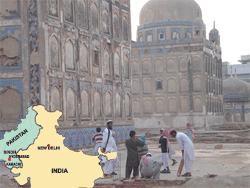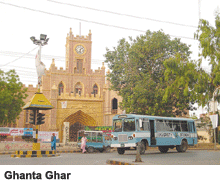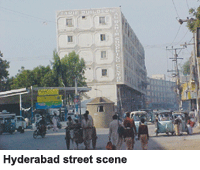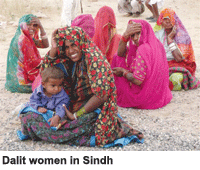Pakistan’s surviving Hindu minority continues to suffer traditional caste-based oppression, compounded by the exploitation of feudal Muslim landlords. Yoginder Sikand reports from Hyderabad, Sindh province
 I had been in Lahore for almost a fortnight, and although there remained much that I wanted to see in the city, I decided to head south-wards to Sindh, hoping to meet up with friends, visit Sufi shrines and, above all, roam the ruins of Mohenjodaro, cradle of the famed Indus Valley civilisation.
I had been in Lahore for almost a fortnight, and although there remained much that I wanted to see in the city, I decided to head south-wards to Sindh, hoping to meet up with friends, visit Sufi shrines and, above all, roam the ruins of Mohenjodaro, cradle of the famed Indus Valley civilisation.
Friends in Lahore had cautioned against travelling by train to Sindh — they warned of ramshackle coaches with broken seats and robber gangs. But since I wanted to see the countryside and also because the price of an air ticket to Hyderabad, Sindh’s largest city after Karachi, was way beyond my lean budget, I disregarded the advice.
Arriving at the station and pushing my way through knots of passengers and droves of porters bearing mountains of luggage on their turbaned heads, I scrambled onto the 42 Down Karakoram Express as it began to roll. Like most Pakistani trains, this one too was made in China, and seemed to have been built to suit small-built Chinese passengers, rather than burly Pakhtuns and Punjabis. Its roof was barely six feet high, and the corridors accommodated just one passenger at a time.
I squeezed into my seat — a hard plank of wood, narrow and bereft of a back-rest, and watched Lahore slip by. We sped past squalid shanties of the decaying city, past little townships with ramshackle houses and makeshift tents fringed with massive heaps of garbage. An hour later, as the sky began to turn grey, we were out in the open countryside. The flat plains were dissected into little squares by rows of eucalyptus and banyan trees, marking individual plots. The land was criss-crossed with brimming canals. These canals were a legacy of the British. They had transformed Punjab into the bread-basket of the entire subcontinent.
I didn’t sleep a wink that night. The cramped seat and bitter cold — I erred in assuming that Pakistan Railways made provision for blankets and sheets for passengers in air-conditioned coaches — made sleep impossible.
So I sat in my seat all night, playing verbal games in my mind and sketching cartoons of fellow travelers in my note-book. Just past midnight, the train stopped at Bahawalpur, and I got off to stretch my legs. The platform was empty, but through the dense curtain of fog, I spied the contours of a minaret and the turrets of what looked like an ancient mosque. I knew there were interesting historical monuments to see in this town in impoverished southern Punjab along the Rajasthan border — the palace of the nawabs of the vast desert kingdom of Bahawalpur, numerous old madrasas, mosques, crumbling ramparts of forts, and ancient Sufi shrines. I had half a mind to get off the train, to break the tedium of the journey and to visit the town I had read much about. But, I had no visa for Bahawalpur.
Whiskers of pale orange sunrays peeped out of a heavy curtain of darkness in the distant sky, two hours later. As the train entered northern Sindh, it became warmer than it had been in Punjab. The countryside was harsh and unexciting — an endless, flat plain that stretched to the horizon, for the most part sandy and parched. Occasionally, small green patchwork fields and clumps of palm trees broke the drab brown monotony. Hidden behind long mud walls, the villages we passed seemed uniformly characterised by neglect and desperate poverty. At 8 a.m in the morning, the train chugged into Hyderabad.
Reza, a friend I had made over the internet, was at the station to receive me. I was bundled into a jeep that hurtled down a road lined with crater-sized potholes towards Qasimabad, which Reza explained, was the largely ethnic Sindhi part of town. We passed by what seemed the empty basin of a vast lake, surrounded by enormous mounds of rotting garbage.
On either side of the road stood unpainted, half-built brick houses, fringed with clogged, fly-infested sewers. Their walls were covered with political graffiti in the distinctive Sindhi script which is closer to Arabic than Persianised Urdu, hailing political parties and heroes. Some blatantly denounced Punjabi domination and called for Sindh’s independence. Narrow, unpa-ved lanes led off the main road into residential localities which it was clearly evident, lacked basic civic amenities. The road traffic followed no rules, and policemen were conspicu-ously absent. A sea of filth and squalour seemed to envelope the entire city.
 There was little to see in Hyderabad (pop.6 million), although it was aggressively advertised as “an enchanting town, where the legacy of the Nawabs still lives on untouched” by the Pakistan Tourism Board. The largest habitation of Sindh province after Karachi, Hyderabad was established in 1766 by Mian Ghulam Shah Kalhoro, a Baluch chieftain, over the ruins of a small fishing village on the banks of the river Indus where the town of Nerunkot razed by Muhammad bin Qasim, the first Arab invader of India, once stood. It was named after Ali, the Prophet’s son-in-law and the first Imam of the Shias, also known by the title of ‘Hyder’.
There was little to see in Hyderabad (pop.6 million), although it was aggressively advertised as “an enchanting town, where the legacy of the Nawabs still lives on untouched” by the Pakistan Tourism Board. The largest habitation of Sindh province after Karachi, Hyderabad was established in 1766 by Mian Ghulam Shah Kalhoro, a Baluch chieftain, over the ruins of a small fishing village on the banks of the river Indus where the town of Nerunkot razed by Muhammad bin Qasim, the first Arab invader of India, once stood. It was named after Ali, the Prophet’s son-in-law and the first Imam of the Shias, also known by the title of ‘Hyder’.
In 1789, the first ruler of the Talpur dynasty, Mir Fateh Ali Khan, made Hyderabad his capital. Under the Talpurs, Hyderabad grew into one of the major commercial centres of South Asia, a melting pot of various races and castes. Traders who settled here included Hindu Lohanas, Amils and Bhaibands and Muslim Khojahs, Bohras, Memons, Baluchis, Persians and Arabs. Cargo ships sailed from Hyderabad bearing a dazzling array of Sindh’s produce — gold-plated silver, enameled jewellery, dyed leather and cloth from central Sindh, carpets, rugs, glazed ceramic tiles and lacquered wood furniture. Ships sailed down the Indus into the Arabian Sea and beyond, to Gujarat and to Arabia, Iran and even China.
Hyderabad passed into British hands in 1843, when they defeated the Talpurs and annexed Sindh into their vast Indian empire. The marauding British razed several grand edifices that Hyderabad’s erstwhile rulers had built, and packed off the remnants of the Talpur family to Calcutta. In the years that followed, the town gradually slipped into the back-waters and was rapidly overshadowed by the port city of Karachi to the south, which emerged as the commercial nerve centre of Sindh.
 Bubbling with excitement, Reza hauled me to his computer, where he showed me a news report of a programme that he had devised to enable rural school-going children in Rajasthan and Sindh to interact with each other over the internet. The initiative had been a runaway success, widely covered in the Sindh media, and many of these children, Reza said, were now passionate advocates of Indo-Pak amity. He scrambled through several files on his computer, showing me all the other samaritan activities he was engaged in — releasing bonded Dalit labourers in interior Sindh from near-slavery conditions; rehabilitating fishermen who were rapidly losing their source of livelihood to large corporations opera-ting massive fishing trawlers; and galvanising protests against a monster dam that the Pakistan government is planning to construct on the Indus in Punjab, which, so Sindhi nationalists argue, will transform much of Sindh into a desert.
Bubbling with excitement, Reza hauled me to his computer, where he showed me a news report of a programme that he had devised to enable rural school-going children in Rajasthan and Sindh to interact with each other over the internet. The initiative had been a runaway success, widely covered in the Sindh media, and many of these children, Reza said, were now passionate advocates of Indo-Pak amity. He scrambled through several files on his computer, showing me all the other samaritan activities he was engaged in — releasing bonded Dalit labourers in interior Sindh from near-slavery conditions; rehabilitating fishermen who were rapidly losing their source of livelihood to large corporations opera-ting massive fishing trawlers; and galvanising protests against a monster dam that the Pakistan government is planning to construct on the Indus in Punjab, which, so Sindhi nationalists argue, will transform much of Sindh into a desert.
The next morning, Ram, a Hindu friend of Reza’s, offered to show me the few monuments of Hyderabad. We sauntered past the enormous Ghanta Ghar or clock tower crowned by a Victorian-style steeple, into the pretentiously named Shahi Bazaar, or royal market. We stopped at a small Shiva temple located in a lane off the main street, and ascended a short flight of marble-topped stairs. “Even now, 60 years after independence, and despite the fact that the Hindus of Pakistan are a vulnerable minority, Dalits are forbidden to enter this temple,” said Ram.
Some blocks from the Shiva temple was a locality inhabited by 20 households of the Valmiki caste. The traditional occupation of the Valmikis is sweeping and clearing animal carcasses, an occupation which places them at the bottom of the Hindu caste hierarchy. The Valmikis of Hyderabad are still engaged in their traditional occupation. Except now most of them are employees of the Hyderabad municipality, and economically better off than before. The covered drains, lined with white bleach powder that ran along the sides of the well-swept lane leading into their locality, the whitewashed walls of their homes and the small, yet neatly kept Valmiki temple in the centre of their settlement provided a refreshing contrast to the nauseating squalor and filth in other parts of the city.
Later that day I met up with Aslam Khwaja, a social activist. A professional English-Urdu translator, who worked with several NGOs, Khwaja was in the process of building a hamlet outside Hyderabad for Hindu Dalit landless labourers who had been rescued from the clutches of powerful waderas (landlords).
 Aslam led me to a tough-looking, middle-aged man by the name of Manu Bhil, who told me his story of justice denied. Several liberal Pakistani newspapers as well as human rights activists had taken up his cause without much success. “I am a poor man, a Hindu of the Bhil caste,” said Manu Bhil. “Life has been tough for us. Our men earned a measly Rs.60 a day for backbreaking work in the scorching sun, and our women got only half of that. But still, with God’s grace, we managed to survive, as our people have done for centuries.”
Aslam led me to a tough-looking, middle-aged man by the name of Manu Bhil, who told me his story of justice denied. Several liberal Pakistani newspapers as well as human rights activists had taken up his cause without much success. “I am a poor man, a Hindu of the Bhil caste,” said Manu Bhil. “Life has been tough for us. Our men earned a measly Rs.60 a day for backbreaking work in the scorching sun, and our women got only half of that. But still, with God’s grace, we managed to survive, as our people have done for centuries.”
But sometime in the mid-1980s, a severe drought in his native Thar Parkar forced Bhil and his entire family to seek employment with a Muslim landlord named Hayat Rind. After some years, Rind and Manu fell out. Rind claimed that Manu had taken an advance from him and therefore refused to pay Manu his wages. Instead he sold him — together with 20 members of his family — to another landlord, Abdur Rahman Marri.
Living conditions for Manu and his family on Marri’s estate were “brutal”. Somehow, a group of social activists got wind of the vast number of Marri’s haris. Under pressure from them, the police raided the estate and liberated 71 bonded labourers, including Manu’s relatives. As ill-luck would have it, at the time of the raid Manu was away, working in another field belonging to Marri, and so remained in his custody. As the landlord’s only remaining captive, he was subjected to severe torture. However because of NGO pressure, he was released in 1996.
This proved to be only a brief respite. Manu and his family were transferred to a camp for freed bonded slaves, but two years later the obdurate Marri and his henchmen raided the camp and kidnapped nine members of Manu’s family, including his aged parents, his wife, brother and four children. Although the governor of Sindh and the high court of the province had issued directives to the police to apprehend Marri, so great is the power of Pakistan’s feudal lords that the orders were ignored. Manu had been on a token hunger strike outside the Hyderabad Press Club since January 2003, to draw attention to his plight. Since then, he had been detained and tortured by the police several times, in a bid to force him to issue a statement to the effect that his family had not been kidnapped. The defiant Bhil, however, had refused to kowtow. “Such is the awesome power of the waderas of Sindh in modern day Pakistan,” recounted Aslam.
 In the evening, we drove out of Hyderabad, past vacant fields and hillocks of bare sand, and swerved off the road onto a sandy track which ran along a narrow canal lined with towering cacti. A couple of miles ahead, we stopped at a clearing encircled by tiny huts made of plastic sheets stretched across wooden poles. Christened Him-matabad or ‘The Abode of Courage’, this 14-acre campus is a rehabilitation centre for some 25 Dalit families from the Koli and Bhil castes, who had recently been rescued by human rights activists from the clutches of cruel landlords.
In the evening, we drove out of Hyderabad, past vacant fields and hillocks of bare sand, and swerved off the road onto a sandy track which ran along a narrow canal lined with towering cacti. A couple of miles ahead, we stopped at a clearing encircled by tiny huts made of plastic sheets stretched across wooden poles. Christened Him-matabad or ‘The Abode of Courage’, this 14-acre campus is a rehabilitation centre for some 25 Dalit families from the Koli and Bhil castes, who had recently been rescued by human rights activists from the clutches of cruel landlords.
At the far end of the settlement, feverish construction activity was going on. Aslam and his group had collected money to build pucca houses for Dalit families — each equipped with two rooms, a toilet and a kitchen. “All our lives we’ve lived in one-roomed mud hovels, like animals. Thanks to God and the help of our brothers, we will now be able to live like human beings,” commented Dali Bai, a gnarled old Koli woman.
We were joined by Lali Koli, hailed as Himmatabad’s voice to the outside world. Born in a desperately poor family, she had spent almost six years as a virtual slave in the private prison of a local landlord. “We Kolis are originally from Gujarat, in India. Our caste occupation was fishing in the deep seas, but poverty drove us to do manual labour in the fields of landlords. In search of work, we migrated to Sindh, before Partition,” explained Lali. “As in India, we Kolis are treated as untouchables.”
Lali and the other women who had gathered around us listened in silence, as Aslam elaborated on the plight of Pakistan’s Dalits. Since Pakistan’s Hindus are a small, scattered, insecure and poor minority, they are preferred as agricultural labour instead of Muslim haris.
As if the urban chaos of Hyderabad and the miserable degradation of Pakistan’s bonded slaves were not depressing enough, I was to discover even greater horrors in the week ahead that I spent with a leftist activist friend, roaming the Sindh countryside.